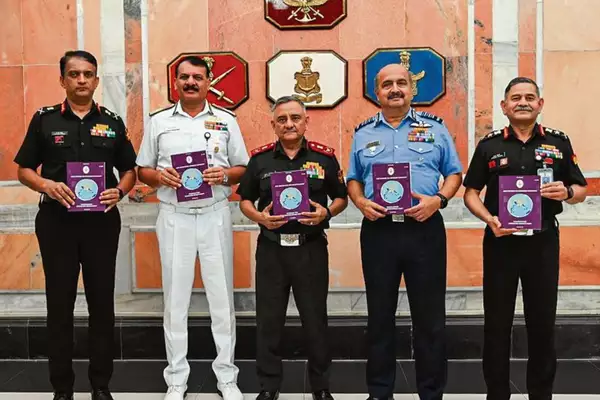The Chief of Defence Staff (CDS) has released the Joint Doctrine for Amphibious Operations, which was unveiled during the Chiefs of Staff Committee (COSC) meeting for guiding the conduct of amphibious operations in today’s complex military landscape.
- The release of this doctrine follows the joint doctrine for cyberspace operations released earlier this year.
- Both documents emphasize the importance of jointness and integration in the armed forces.
About the Joint Doctrine for Amphibious Operations:
- The doctrine provides critical guidance for commanders on executing amphibious operations.
- It is designed to address the complexities of modern military environments and enhance operational effectiveness in the Indian Ocean Region.
Operational Impact:
- The doctrine empowers the armed forces to execute a wide range of operations effectively.
- It strengthens the strategic posture of India by enhancing capabilities in the Indian Ocean Region.
Strategic and Tactical Integration:
- Enhances the ability of the armed forces to operate seamlessly across different domains.
- Supports the strategic integration of various military branches for comprehensive operational effectiveness.
About Amphibious Operations:
- Amphibious operations involve attacks launched from the sea by naval and landing forces.
- These operations include landing on hostile shores with extensive air support.
- It demonstrates cohesion and integration among armed forces.
Role in Multi-Domain Operations:
- Amphibious operations are a key component of multi-domain operations.
- They exemplify the integration and cohesion among different branches of the armed forces, showcasing their ability to operate effectively across multiple domains.
Types of Operations:
- Includes amphibious withdrawals, demonstrations, and raids.
- May involve airborne operations conducted in conjunction with amphibious operations.
- Army forces are employed in various types of amphibious operations.
Operational Concept
- Firepower Preparation: Initial preparation includes firepower from naval guns, missiles, and aircraft.
- Assault Landing: Accomplished using landing craft, air and amphibious vehicles, often in conjunction with airborne operations.
- Advance and Support:
- After securing initial objectives, the force moves rapidly to intermediate and final objectives.
- Naval support continues until sufficient combat and administrative support forces are established ashore.
- Adaptations: In the face of enemy nuclear capabilities, smaller forces might advance directly to deep objectives without stopping at the waterline, adding depth to the beachhead through simultaneous operations.
Ref: Source
| UPSC IAS Preparation Resources | |
| Current Affairs Analysis | Topperspedia |
| GS Shots | Simply Explained |
| Daily Flash Cards | Daily Quiz |
Frequently Asked Question:
What is the purpose of the Joint Doctrine for Amphibious Operations?
The doctrine guides commanders in executing amphibious operations and addresses the complexities of modern military environments.
What operations are included in amphibious operations?
Amphibious operations include withdrawals, demonstrations, raids, and may involve airborne operations in conjunction with naval forces.
How does the doctrine enhance India’s strategic posture?
It strengthens India’s strategic position by enhancing military capabilities in the Indian Ocean Region and promoting joint integration across branches.
What role does firepower play in amphibious operations?
Firepower preparation involves naval guns, missiles, and aircraft, which are critical in preparing for assault landings.
What is the significance of multi-domain operations in the doctrine?
Amphibious operations are integral to multi-domain operations, demonstrating the ability of armed forces to operate cohesively across different military domains.



